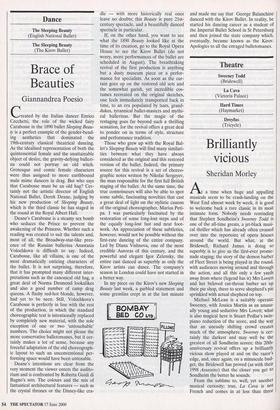Dance
The Sleeping Beauty (English National Ballet) The Sleeping Beauty (The Kirov Ballet)
Brace of Beauties
Giannandrea Poesio
Created by the Italian dancer Enrico Cecchetti, the role of the wicked fairy Carabosse in the 1890 ballet Sleeping Beau- ty is a perfect example of the gender-bend- ing aesthetics that dominated the 19th-century classical theatrical dancing. As the idealised representation of both the quintessential female and the unattainable object of desire, the gravity-defying balleri- na could not portray an old witch. Grotesque and comic female characters were thus assigned to more earthbound male mime dancers in drag. But who says that Carabosse must be an old hag? Cer- tainly not the artistic director of English National Ballet, Derek Deane, judging by his new production of Sleeping Beauty, which is the third classic he has staged in the round at the Royal Albert Hall.
Deane's Carabosse is a steamy sex bomb who seduces the Prince to prevent the awakening of the Princess. Whether such a reading was created to suit the talents and, most of all, the Broadway-star-like pres- ence of the Russian ballerina Anastasia Volochkova is difficult to say. Indeed, Carabosse, like all villains, is one of the most dramatically enticing characters of the ballet. It is not surprising, therefore, that it has prompted many different inter- pretations such as the canonical old hag, a great deal of Norma Desmond lookalikes and also a good number of camp drag queens. A flashy red-hot blonde, however, had yet to be seen. Still, Volochkova's Carabosse is perfectly in line with the rest of the production, in which the standard choreographic text is intentionally replaced by completely new material, with the sole exception of one or two 'untouchable' numbers. The choice might not please the more conservative balletomanes, but it cer- tainly makes a lot of sense, because any forceful adaptation of the old choreograph- ic layout to such an unconventional per- forming space would have been untenable.
Deane's intentions are clear from the very moment the viewer enters the audito- rium and is confronted by Roberta Guidi di Bagno's sets. The colours and the mix of fantastical architectural features — such as the crystal thrones or the Disney-like cra- dle — with more historically real ones leave no doubts; this Beauty is pure 21st- century spectacle, and a beautifully danced spectacle in particular.
If, on the other hand, you want to see what the 1890 Beauty looked like at the time of its creation, go to the Royal Opera House to see the Kirov Ballet (do not worry, more performances of the ballet are scheduled in August). The breathtaking revival of the first production is anything but a dusty museum piece or a perfor- mance for specialists. As soon as the cur- tain goes up on the restored old sets and the somewhat garish, yet incredible cos- tumes recreated on the original sketches, one feels immediately transported back in time, to an era populated by tsars, grand- dukes, tyrannical ballet-masters and mythi- cal ballerinas. But the magic of the restaging goes far beyond such a thrilling sensation, for the revival offers a great deal to ponder on in terms of style, structure and performance tradition.
Those who grew up with the Royal Bal- let's Sleeping Beauty will find many similari- ties between what they have always considered as the original and this restored version of the ballet. Indeed, the primary source for this revival is a set of choreo- graphic notes written by Nikolai Sergeyev, the man responsible for the first full British staging of the ballet. At the same time, the true connoisseurs will also be able to spot some subtle, fascinating novelties that cast a great deal of light on the stylistic canons of the original choreographer, Marius Peti- pa. I was particularly fascinated by the restoration of some long-lost steps and of the equally long-lost fast and neat foot- work. An appreciation of these subtleties, however, would not be possible without the first-rate dancing of the entire company. Led by Diana Vishnova, one of the most credible Auroras of this century, and the powerful and elegant Igor Zelensky, the entire cast danced as superbly as only the Kirov artists can dance. The company's season in London could have not started in a better way.
In my piece on the Kirov's new Sleeping Beauty last week, a garbled statement and some gremlins crept in at the last minute and made me say that George Balanchine danced with the Kirov Ballet. In reality, he started his dancing career as a student of the Imperial Ballet School in St Petersburg and then joined the state company which, eventually, became known as the Kirov. Apologies to all the enraged balletomanes.










































































 Previous page
Previous page